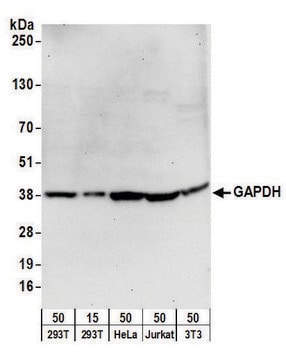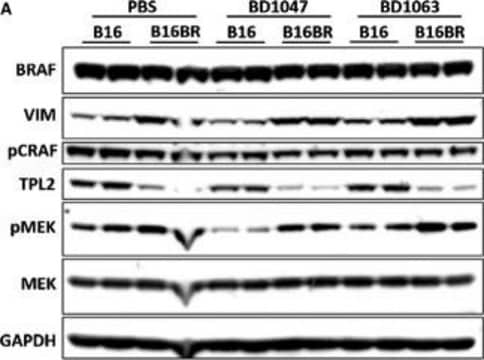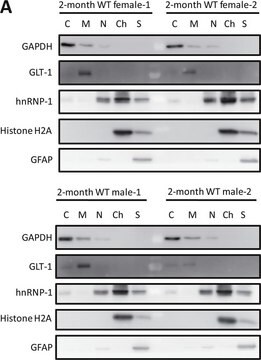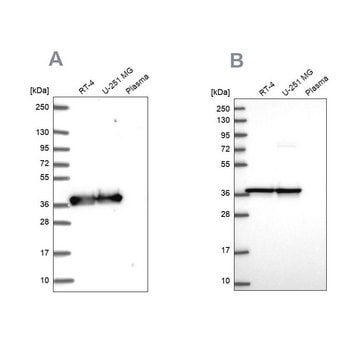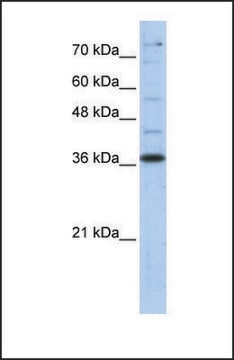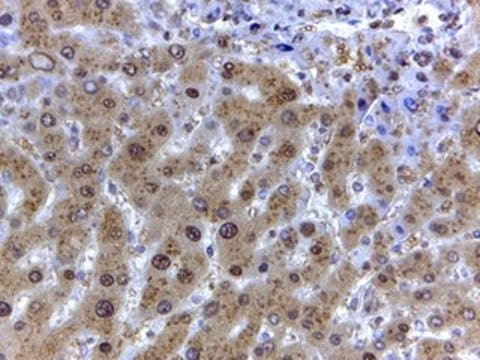G8795
Anti-GAPDH antibody, Mouse monoclonal
clone GAPDH-71.1, purified from hybridoma cell culture
Synonim(y):
GAPDH Antibody - Monoclonal Anti-GAPDH antibody produced in mouse, Gapdh Antibody, Anti-G3PD, Anti-G3PDH, Anti-Glyceraldehyde-3-phosphate dehydrogenase, Loading Control
About This Item
Polecane produkty
pochodzenie biologiczne
mouse
Poziom jakości
białko sprzężone
unconjugated
forma przeciwciała
purified from hybridoma cell culture
purified immunoglobulin
rodzaj przeciwciała
primary antibodies
klon
GAPDH-71.1, monoclonal
Postać
buffered aqueous solution
masa cząsteczkowa
antigen ~37 kDa
reaktywność gatunkowa
bovine, turkey, canine, chicken, monkey, mink, mouse, human, rabbit, rat, hamster
spodziewany brak reakcji z
prokaryotes
opakowanie
antibody small pack of 25 μL
stężenie
~1 mg/mL
metody
immunocytochemistry: suitable
indirect ELISA: suitable
microarray: suitable
western blot: 0.025-0.05 μg/mL using A431 total cell extract
izotyp
IgM
numer dostępu UniProt
Zastosowanie
research pathology
Warunki transportu
dry ice
temp. przechowywania
−20°C
docelowa modyfikacja potranslacyjna
unmodified
informacje o genach
human ... GAPDH(2597)
mouse ... Gapdh(14433)
rat ... Gapdh(24383)
Opis ogólny
Specyficzność
Immunogen
Zastosowanie
- protein extracted from heart tissue of mice at a working dilution of 1:25,000
- myelin and axogliasomal fractions from human CNS
- nuclear and cytoplasmic fractions from TBP-13Q and TBP-105Q PC12 cells following recovery from heat shock
- protein from bovine immortalized luteal endothelial cells
- renal tubular epithelial cell extract
- proteins from mouse embryonic fibroblasts
- protein extract from ventricular myocardium tissues
- A431 total cell extract at a working concentration of 0.025-0.05μg/mL
Działania biochem./fizjol.
Postać fizyczna
Przechowywanie i stabilność
For extended storage, freeze in working aliquots. Repeated freezing and thawing, or storage in “frostfree” freezers, is not recommended. If slight turbidity occurs upon prolonged storage, clarify the solution by centrifugation before use. Working dilution samples should be discarded if not used within 12 hours.
Oświadczenie o zrzeczeniu się odpowiedzialności
Not finding the right product?
Try our Narzędzie selektora produktów.
polecane
Kod klasy składowania
12 - Non Combustible Liquids
Klasa zagrożenia wodnego (WGK)
WGK 1
Temperatura zapłonu (°F)
Not applicable
Temperatura zapłonu (°C)
Not applicable
Środki ochrony indywidualnej
Eyeshields, Gloves, multi-purpose combination respirator cartridge (US)
Certyfikaty analizy (CoA)
Poszukaj Certyfikaty analizy (CoA), wpisując numer partii/serii produktów. Numery serii i partii można znaleźć na etykiecie produktu po słowach „seria” lub „partia”.
Masz już ten produkt?
Dokumenty związane z niedawno zakupionymi produktami zostały zamieszczone w Bibliotece dokumentów.
Klienci oglądali również te produkty
Produkty
Loading controls in western blotting application.
Kontrole ładowania w aplikacji western blotting.
Warburg effect enhances glucose to lactate conversion in tumor cells, regardless of oxygen levels; impacting cancer metabolism since 1924.
Nasz zespół naukowców ma doświadczenie we wszystkich obszarach badań, w tym w naukach przyrodniczych, materiałoznawstwie, syntezie chemicznej, chromatografii, analityce i wielu innych dziedzinach.
Skontaktuj się z zespołem ds. pomocy technicznej







